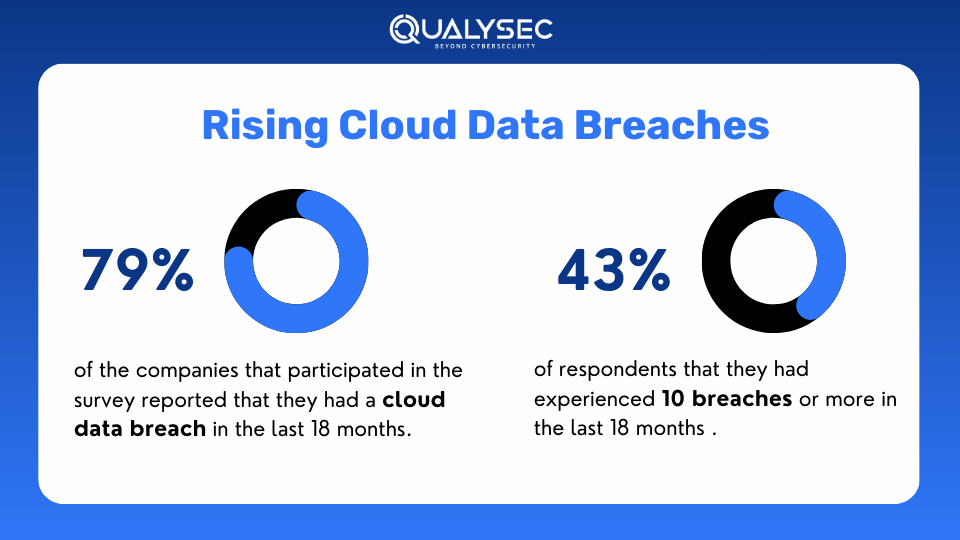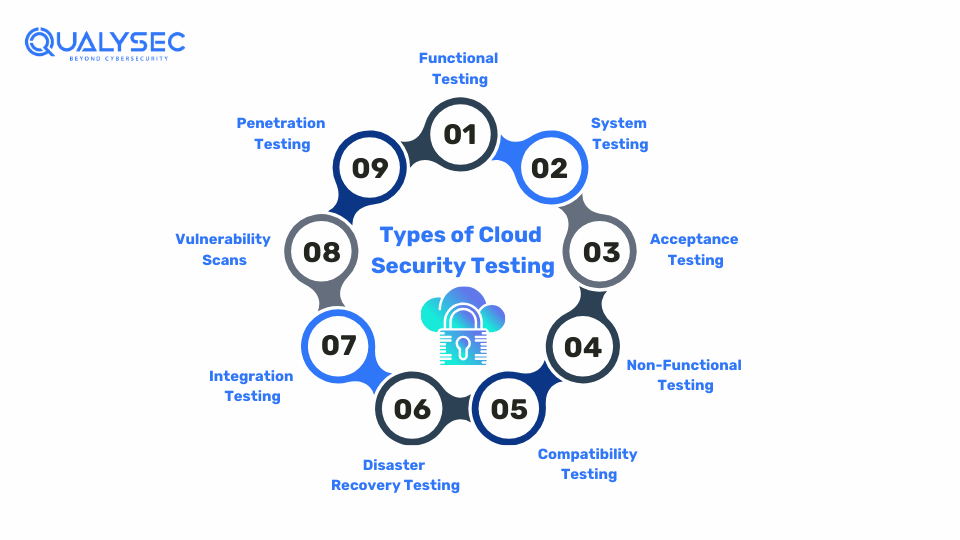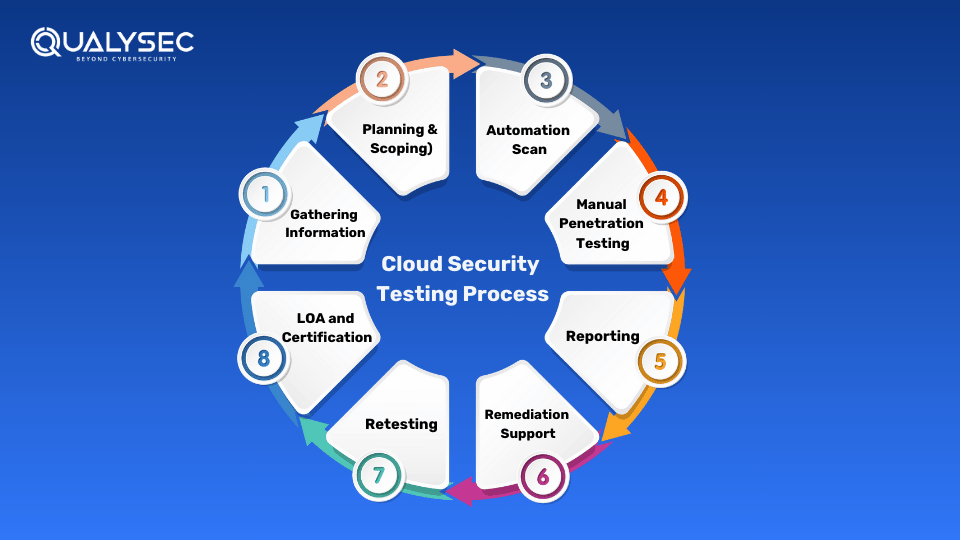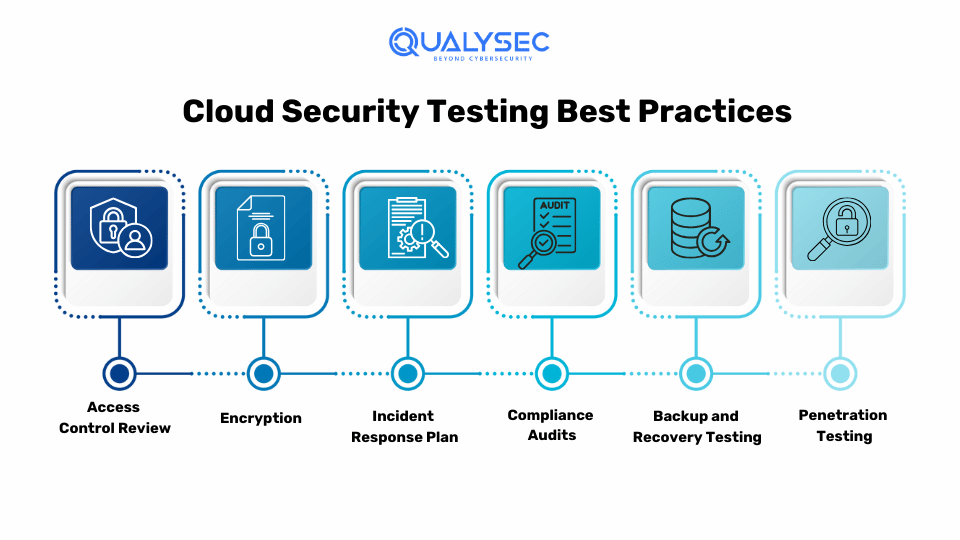© 2024 Qualysec.com Disclaimer Privacy Policy Terms & Conditions

Cloud security testing helps protect the cloud environment by identifying and mitigating vulnerabilities. Almost every business functioning online uses the cloud in some other way. Be it for scaling, business operations, or data storage, cloud computing offers an array of benefits for business growth. However, they are not immune to cyber threats and need constant protection from attackers.
According to a recent survey, 45% of breaches are cloud-based. This comes along with the fact that over 80% of companies have faced at least one cloud attack in the past year itself, where 27% of them experienced a public cloud security incident.
So, if your organization uses cloud services, such as Amazon Web Services (AWS) or Google Cloud Platform (GCP), this blog is for you. Here, we will discuss cloud security testing, how can it help protect your cloud infrastructure, and how to do it effectively.
Cloud security testing is a type of cybersecurity testing done on the cloud infrastructure to find vulnerabilities and security loopholes that hackers could exploit. It is done to ensure that the data and resources present in the cloud are protected from cyberattacks.
It also examines the cloud provider’s security policies, procedures, and controls. Then it attempts to find security weaknesses that could lead to data breaches and other security incidents. It is often performed by third-party security auditors or penetration testing providers.
Security testers perform this task using various automated and manual testing techniques. The results of the testing are used to enhance the security measures of the cloud infrastructure. Along with this, the testing certificate also helps the business achieve the necessary compliance with their respective industry standards.

The main reason to conduct cloud security testing is to protect the data and resources in the cloud from attackers. Additionally, it offers a wide range of benefits, such as:
There are quite a few types of cloud security testing services that collectively help secure the cloud environment, such as:

Functional testing involves testing your application’s performance. By evaluating each function according to its pre-defined requirements, you can ensure that the application operates as it is intended.
System testing provides a comprehensive look at the entire software system. It goes beyond individual components, assessing the complete system to ensure all requirements and functionalities work together effectively. Security testing is an essential part of this process, ensuring that vulnerabilities are identified and addressed.
Acceptance testing ensures your cloud security solution meets your business needs. It’s the final check to confirm that the software aligns with your organization’s goals.
Non-functional testing focuses on the user experience beyond just functionality. It carefully evaluates service quality, reliability, usability, and response times to ensure the software provides an excellent experience.
Compatibility testing ensures software works smoothly in different environments. It checks that the software operates well across various cloud platforms and operating systems.
Disaster recovery testing checks how well an application can recover from unexpected security issues. It measures recovery time to ensure the application can quickly bounce back with minimal data loss enhancing application security.
Integration testing checks for issues that may occur when different software components work together. It ensures these modules communicate and collaborate effectively, creating a seamless software ecosystem.
These security scans use automated software or tools to test the cloud for known vulnerabilities, providing valuable insights by identifying potential security gaps through vulnerability scanning.
Penetration testing involves ethical hackers simulating attacks on the cloud to find hidden vulnerabilities. This helps in checking the cloud’s strength in preventing cyberattacks and also helps in improving them.
While there are a few different ways to do cloud security testing, the best option is to combine automated vulnerability scanning with manual penetration testing. Here’s how it should be done:

Want to see a real cloud security testing report? Click the link below and download one right now!
There is a wide range of cloud security testing tools that are used worldwide. However, only a handful of them provide the desired results, such as:
For a comprehensive review, it is important that your cloud security testing covers essential areas, such as:

Check who has access to your cloud resources and data. Ensure only authorized users have permission to access them to minimize the risk of unauthorized access. Use measures like least privilege, where users are given minimum access needed for their roles as part of a cloud security assessment.
Encrypt data both at rest and in transit to protect it from unauthorized access and tampering. Use strong encryption standards to ensure that sensitive information remains protected. Encryption is an extra layer of security, making it harder for attackers to access your data even if they breach your defenses.
Develop an effective incident response plan for responding to security incidents. Ensure that all team members know their roles and can act quickly to mitigate any potential damage. A well-prepared incident response plan helps minimize impact and restore normal operations efficiently.
Regularly conduct compliance audits to ensure your cloud environment meets industry regulations and standards, for example, PCI DSS, ISO 27001, HIPAA, etc. These audits help identify vulnerable areas and provide guidance on necessary improvements. Staying compliant not only enhances security but also builds trust with customers and partners.
Test your backup and recovery procedures to ensure you can quickly restore data in case of a security incident. Effective backup and recovery strategies help minimize downtime and data loss during a breach. Regular testing ensures that your backup systems are reliable and can be depended upon when needed.
Perform simulated cyber-attacks on your cloud environment to identify security weaknesses. Cloud penetration testing helps uncover potential entry points for hackers and tests your defenses. This practice helps improve your security posture by finding and fixing vulnerabilities that can cause data breaches and other security incidents.
Interested in penetration testing? Qualysec has secured over 500 applications, both web and cloud-based for 110+ clients. Talk to our security experts today and start securing your cloud environment and business today!

Talk to our Cybersecurity Expert to discuss your specific needs and how we can help your business.
While cloud security testing provides numerous benefits there are a few challenges testers face, such as:
The complex structure of a cloud environment and the unique threats it faces require regular security testing if you want to protect its data and resources. Cloud security testing not only helps you fix security issues but also helps with achieving compliance and building customer trust.
To properly secure your cloud infrastructure, you need a good cloud security testing provider like Qualysec. You can check our track record, our methodologies, our certifications, and our customization options before you choose us. In the end, it is all about protecting the very data your business relies upon.
A:A cloud security assessment identifies vulnerabilities, configuration issues, and potential threats in the cloud infrastructure. Additionally, it analyses the configuration of the cloud service provider and reviews potential threats from the internet.
A: It is a process of testing cloud-based applications to identify vulnerabilities that attackers cold exploit for unauthorized access and data breaches.
A: The three categories of cloud security are:
A: A third-party security testing or penetration testing provider provides cloud security testing services. This is because a security certificate from an independent provider is more trustworthy than in-house testing.

Pabitra Sahoo is a cybersecurity expert and researcher, specializing in penetration testing. He is also an excellent content creator and has published many informative content based on cybersecurity. His content has been appreciated and shared on various platforms including social media and news forums. He is also an influencer and motivator for following the latest cybersecurity practices.





Plot No:687, Near Basudev Wood Road,
Saheed Nagar, Odisha, India, 751007
No: 72, OJone India, Service Rd, LRDE Layout, Doddanekundi, India,560037
© 2024 Qualysec.com Disclaimer Privacy Policy Terms & Conditions


No: 72, OJone India, Service Rd, LRDE Layout, Doddanekundi, India,560037
© 2024 Qualysec.com Disclaimer Privacy Policy Terms & Conditions